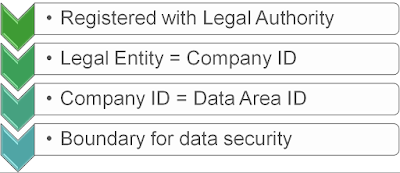Company, Legal entity, Data Area ID--What's the Difference?
You have probably
heard all three terms used in various documents or have seen them in the user
interface-or maybe not. The bottom line is that fundamentally, they are all the
same. (At least in the current version that is true).
By definition, a
"legal entity" is an organization that is identified through
registration with a legal authority. Legal entities can enter into contracts
and are required to prepare statements that report on their performance.
A company is a type
of legal entity. In this release of Microsoft Dynamics 365 for Finance and
Operations, companies are the only kind of legal entity that you can create,
and every legal entity is associated with a company ID.
This association
exists because some functional areas in the system use a company ID, or Data
Area ID, in their data models. In these functional areas, companies are used as
a boundary for data security. Users can access data only for the company that
they are currently logged on to and have been granted permissions to.
Organization administration > Organizations >
Legal Entities
Five
noteworthy features of legal entities:
- You can mark a company as a Consolidation company. This is the only type of company that allows a consolidation to be run. This type of company cannot have regular transactions.
- You can mark a company as an Elimination company. This is the only type of company that allows elimination rules to be created and run. This type of company cannot have regular transactions.
- You can mark a company as both an Elimination and a Consolidation. This allows both consolidations and eliminations to be performed in the same company.
- The country code that you link to the primary address on the legal entity controls the country specific features that are enabled for each legal entity. This is different than previous versions of Dynamics AX where you had to turn configuration keys on and off and the control is not at a legal entity level.
- The company ID is what the DataAreaID is. Every transactions that is performed in each legal entity is stamped with the company ID in a column in each table called the DataAreaID. Some tables do not have a data area ID. In that case the data is shared across all the companies.
FAQ:
Should I create separate consolidation and elimination companies?
A: Well…I know I keep saying this when I ask
questions in my blog, (and literally as I am typing this, I realize that I have
a problem…I am asking questions and answering them…hmmm) but--there is no right
or wrong answer to this question.
So, with that being
said, I generally prefer to combine my consolidation and elimination companies
together. Although, I do have clients that separate them for statutory reporting
requirements or just because they prefer it that way. You will not fail your implementation no matter which option you select. The business process for month end will just look slightly different.



Comments
Post a Comment